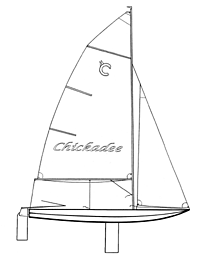Chickadee
Scow
It's small-boat review time again. I remember the first time I ever took a boat out by myself. It was a calm day on Lake Washington. I was about 14. I rented an 8-foot Sea Scouter dinghy. It weighed about 800 pounds and its only sail was held to the mast with shower curtain rings. I sat on the thwart, sculled my way out of the marina and headed straight downwind for two hours. Stupid, but understandable, considering.
The wind of course died, leaving me up against the lee shore of the Lake Washington floating bridge, known for the nasty square chop that develops there. I could not make that horrible little tub of a boat go to weather at all. Not that I even knew what it took to make any boat go to weather. I recall watching the Star class 24-footers slide by effortlessly in the light breeze maybe 50 feet away from me; to leeward no less. "Why can't I do that?" I ended up rowing the stubby little boat back to the marina with its stubby little oars; all the time the boom banging me upside the head as I didn't have the smarts to lower the stubby little sail. It occurred to me that maybe there was more to this sailing thing than I had suspected.
I love little sailboats. I know I'd get along just fine with this Chickadee designed by Canadian Chris Koper. Chris markets the Chickadee as kits or he would be happy to provide you with plans and patterns along with an instructional video so you can build your own. Chris is passionate about his Chickadee. In fact, it seems to be that the smaller the boat the more passionate the builders are. Maybe it has something to do with the intimate physical connection the sailor makes with a small boat. Regardless, Chris is a zealot for this little trainer. He says it's the perfect next step for a sailor graduating from the Optimist pram.
The basic design is based upon a 12-foot scow designed by Chris's dad Jack in 1956 in South Africa, the Dabchick. They have built 3,500 Dabchicks to date. That's impressive. The scow form on the Chickadee makes for a boat that is quick to plane and quite stable and forgiving. Deadrise is almost constant but flattens out amidships. The increase in deadrise aft prevents the leeward chine from digging in when the boat is heeled. The scow hull form takes a little time to get used to. The squared off bow is not elegant at first glance but can be quite shapely when the plywood is sufficiently tortured. When I brought up the question of scow aesthetics to Chris the sound of hackles rising in Mississauga was clearly audible in Seattle. Like any proud papa, Chris thinks his little scows are beauties. I have to agree. They do have a certain charm.
The rig couldn't be any simpler. According to Chris, the boat sails well with just the main up for beginners or very light crews. The responsiveness of the Chickadee's hull form means that the beginner will get feedback from the boat quickly and technique improvements will be immediately rewarded with better performance. There is easily enough performance designed into this boat to keep an expert happy, too.
If you have never sailed a good boat with a gaff rig you might be in for a surprise. If the peak angle of the gaff is high enough you can point just fine. Off the wind the gaff rig exposes a lot of sail area. Obviously, with a rig like this a good vang would be very helpful, but you just don't see them on catboats and that may be a function of the low gooseneck. In a breeze you might find it's more prudent to tack the boat downwind rather than risk the excitement of a flying jibe with that big boom.
The cockpit is a trough type open at the transom. Plywood is bent to an arc to form the cockpit sides and sole. There is a gentle, compound curvature in the foredeck.
I bet if I had been in a Chickadee back in 1962 I wouldn't have had to row back to the marina. It was humiliating in front of those racing dinghies and it took a week for the bruises on my head to heal.

Comments